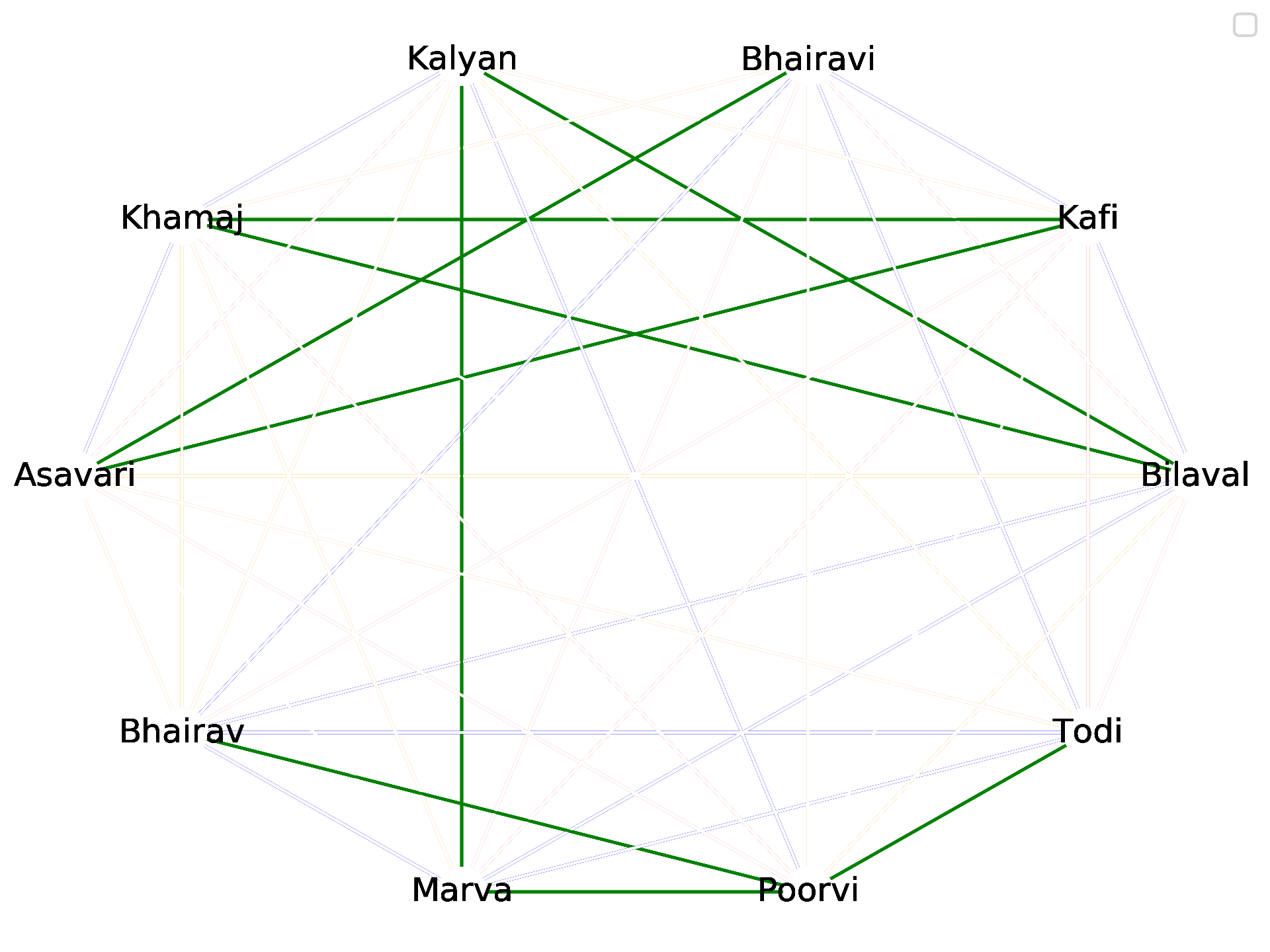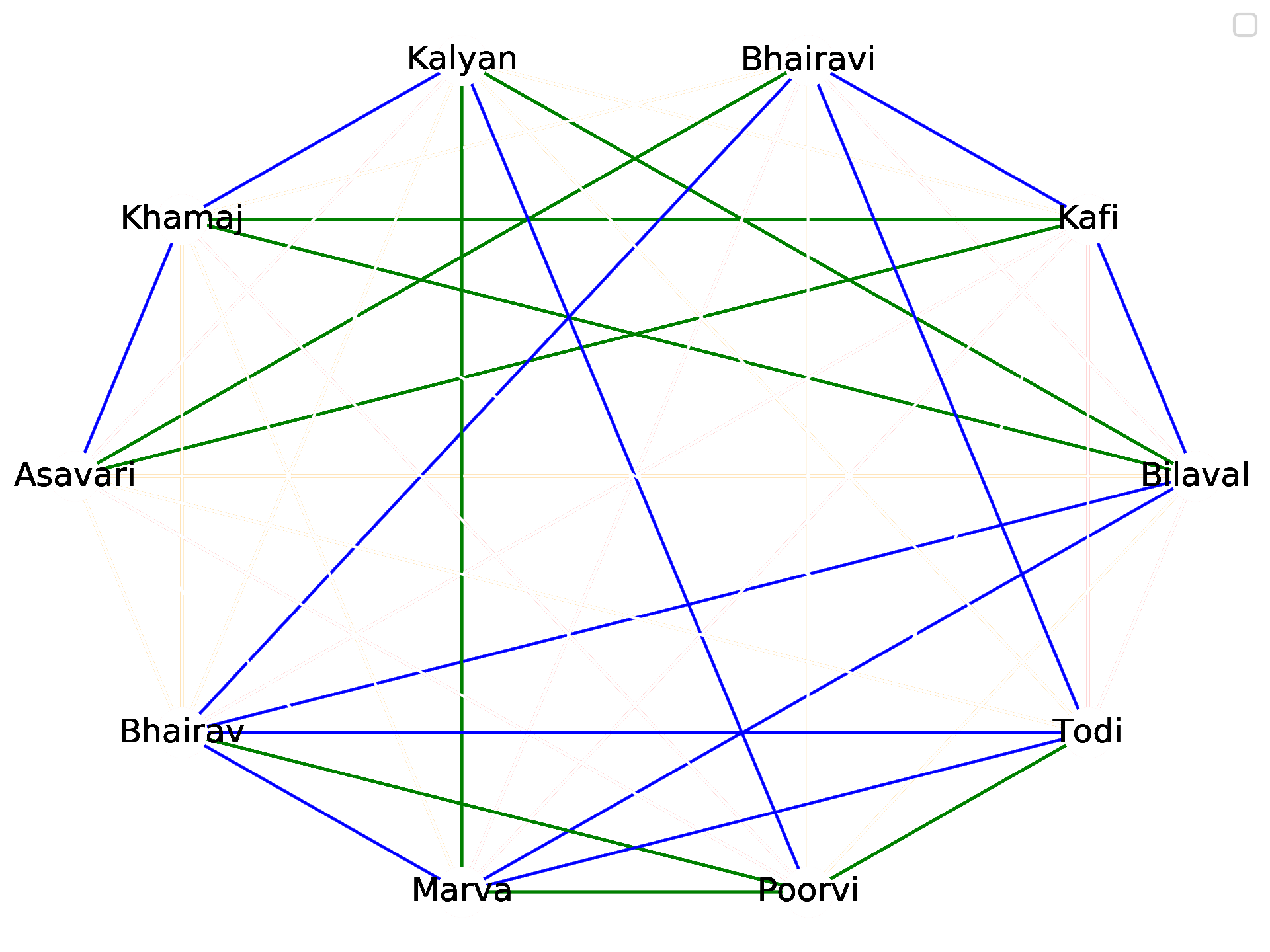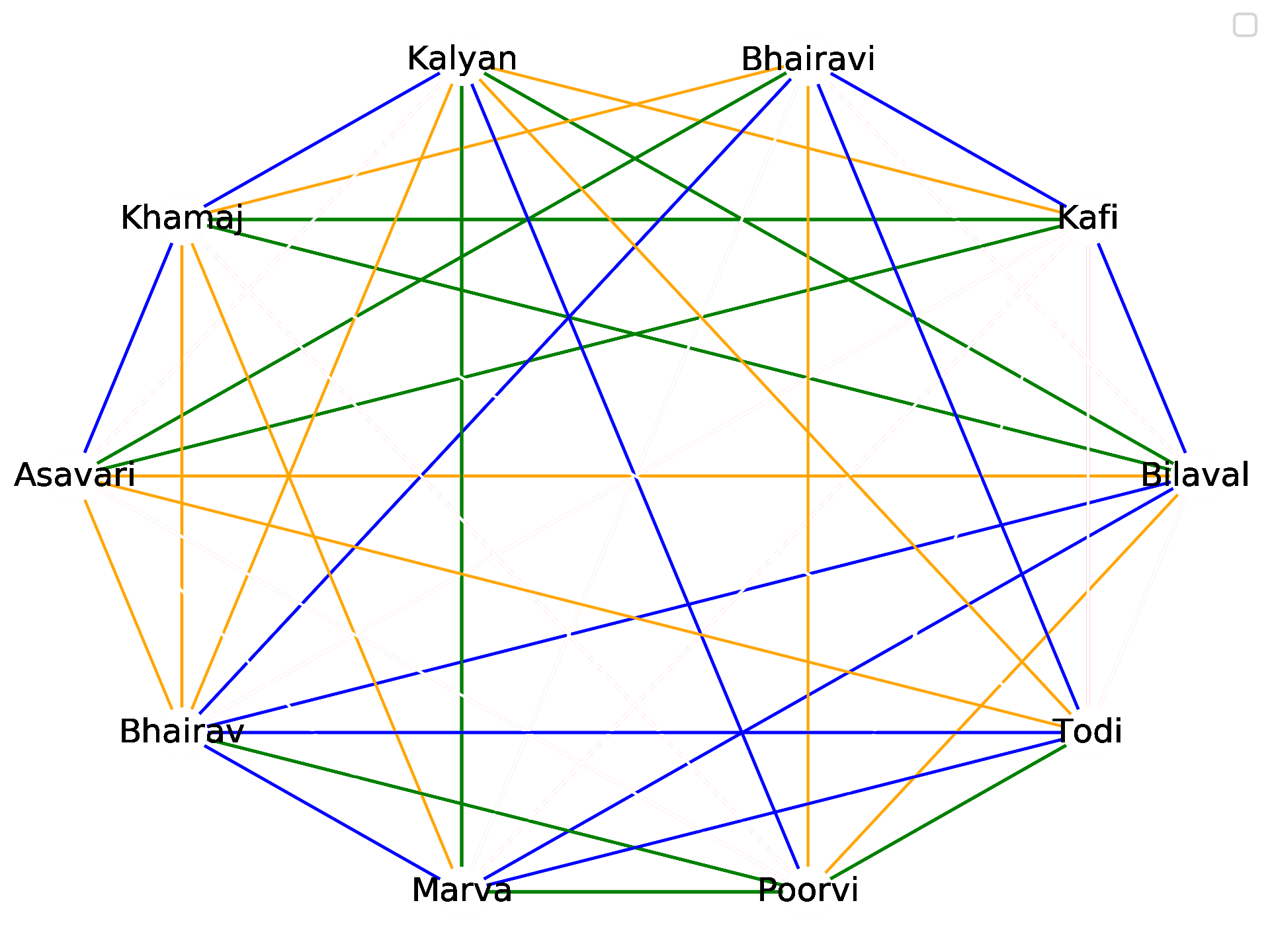Exploring the relationships between thaats in Hindustani Music
On thaats: the diff graph
The wikipedia article on Thaats lists the following 10 Hindustani Raags along with the most famous raag associated in the third column.
| 1 | Bilaval | Bilaval | S R G M P D N Ś | Ionian | 29th | Dheerashankarabharanam |
| 2 | Kafi | Kafi | S R g M P D n Ś | Dorian | 22nd | Kharaharapriya |
| 3 | Bhairavi | Bhairavi | S r g M P d n Ś | Phrygian | 8th | Hanumatodi |
| 4 | Kalyan | Yaman | S R G m P D N Ś | Lydian | 65th | (Mecha) Kalyani |
| 5 | Khamaj | Khamaj | S R G M P D n Ś | Mixolydian | 28th | Harikambhoji |
| 6 | Asavari | Asavari | S R g M P d n Ś | Aeolian | 20th | Natabhairavi |
| 7 | Bhairav | Bhairav | S r G M P d N Ś | Double Harmonic | 15th | Mayamalavagowla |
| 8 | Marva | Marva | S r G m P D N Ś | - | 53rd | Gamanashrama |
| 9 | Poorvi | Poorvi | S r G m P d N Ś | - | 51st | Kamavardhani |
| 10 | Todi | Miyan ki Todi | S r g m P d N Ś | - | 45th | Shubhapantuvarali |
We asked the question, if we only consider the swaras associated with each thaat as a string, can we investigate the graph of thaats constructed with edge-weights as the string diff of the notes.
| num | name | notes |
| 1 | Bilaval | RGMPDN |
| 2 | Kafi | RgMPDn |
| 3 | Bhairavi | rgMPdn |
| 4 | Kalyan | RGmPDN |
| 5 | Khamaj | RGMPDn |
| 6 | Asavari | RgMPdn |
| 7 | Bhairav | rGMPdN |
| 8 | Marva | rGmPDN |
| 9 | Poorvi | rGmPdN |
| 10 | Todi | rgmPdN |
Let us first construct the Graph. I write the edge list to file first.
import pandas as pd
from networkx import *
import matplotlib.pyplot as plt
DF=pd.DataFrame(data)
DF.columns=DF.iloc[0]
DF = DF.drop(0)
def cmp(A, B):
count = 0
for a,b in zip(A,B):
if a != b:
count += 1
return count
with open('thaat_edge_list.txt', 'w') as f:
for i in range(1,11):
for j in range(i+1,11):
E = cmp(str(list(DF['notes'].loc[DF['num'] == i])[0]), str(list(DF['notes'].loc[DF['num'] == j])[0]))
f.write(str(i) + '\t'+ str(j) + '\t' + str(E) + '\n')
G = read_weighted_edgelist('thaat_edge_list.txt',delimiter='\t',
nodetype=int,
encoding='utf-8')
We can now visualize the graph by coloring the edges by the edge weight.
colordict = {1:'g',
2:'w',
3:'w',#'orange',#'orange',
4:'w',#'r',
5:'w'}#'k'}
nodes = [i for i in range(1,11)]
labels = {i:DF['name'][i] for i in range(1,11)}
draw_circular(G,with_labels=True,nodelist=nodes,
edge_color=[colordict[G[i][j]['weight']] for i,j in G.edges()],
node_color='w',
labels=labels)
plt.savefig('thaat_diff-1.png',dpi=300)
The green edges show edge weight of 1, i.e. these thaats differ by one note.

colordict = {1:'g',
2:'b',
3:'w',#'orange',#'orange',
4:'w',#'r',
5:'w'}#'k'}
nodes = [i for i in range(1,11)]
labels = {i:DF['name'][i] for i in range(1,11)}
draw_circular(G,with_labels=True,nodelist=nodes,
#width=[G[i][j]['weight'] for i,j in G.edges()]
edge_color=[colordict[G[i][j]['weight']] for i,j in G.edges()],
node_color='w',
labels=labels)
plt.savefig('thaat_diff-1,2.png',dpi=300)
These include thaats that differ by one or two notes

colordict = {1:'g',
2:'b',
3:'orange',#'orange',
4:'w',#'r',
5:'w'}#'k'}
nodes = [i for i in range(1,11)]
labels = {i:DF['name'][i] for i in range(1,11)}
draw_circular(G,with_labels=True,nodelist=nodes,
#width=[G[i][j]['weight'] for i,j in G.edges()]
edge_color=[colordict[G[i][j]['weight']] for i,j in G.edges()],
node_color='w',
labels=labels)
plt.savefig('thaat_diff-1,2,3.png',dpi=300)
.. and those that differ by three…

colordict = {1:'g',
2:'b',
3:'orange',#'orange',
4:'r',
5:'w'}#'k'}
nodes = [i for i in range(1,11)]
labels = {i:DF['name'][i] for i in range(1,11)}
draw_circular(G,with_labels=True,nodelist=nodes,
#width=[G[i][j]['weight'] for i,j in G.edges()]
edge_color=[colordict[G[i][j]['weight']] for i,j in G.edges()],
node_color='w',
labels=labels)
plt.savefig('thaat_diff-1,2,3,4.png',dpi=300)
… and finally up to four notes (in red).

What thaats are similar to all other thaats? Look at number of thaats at most 2 notes different
degreedict = {}
for i in range(1,11):
count =0
degreedict[i] = {'count':0,'name':labels[i]}
for j in range(1, 11):
if i!=j and G[i][j]['weight'] <= 2.0:
count += 1
degreedict[i]['count'] = count
for k in degreedict.keys():
print(degreedict[k]['name'],degreedict[k]['count'])
('Bilaval', 5)
('Kafi', 4)
('Bhairavi', 4)
('Kalyan', 4)
('Khamaj', 4)
('Asavari', 3)
('Bhairav', 5)
('Marva', 5)
('Poorvi', 4)
('Todi', 4)
What thaats are most different from other thaats? Look at number of thaats that are more than 3 notes different.
degreedict = {}
for i in range(1,11):
count =0
degreedict[i] = {'count':0,'name':labels[i]}
for j in range(1, 11):
if i!=j and G[i][j]['weight'] > 3.0:
count += 1
degreedict[i]['count'] = count
for k in degreedict.keys():
print(degreedict[k]['name'],degreedict[k]['count'])
('Bilaval', 2)
('Kafi', 4)
('Bhairavi', 3)
('Kalyan', 2)
('Khamaj', 2)
('Asavari', 3)
('Bhairav', 1)
('Marva', 3)
('Poorvi', 3)
('Todi', 3)
Putting it all together as an animation makes it clear that for the most part thaats are equally different from each other.

While these are purely abstract relationships between thaats, we will be exploring the significance of these relationships on the raags that constitute each thaat next week!



